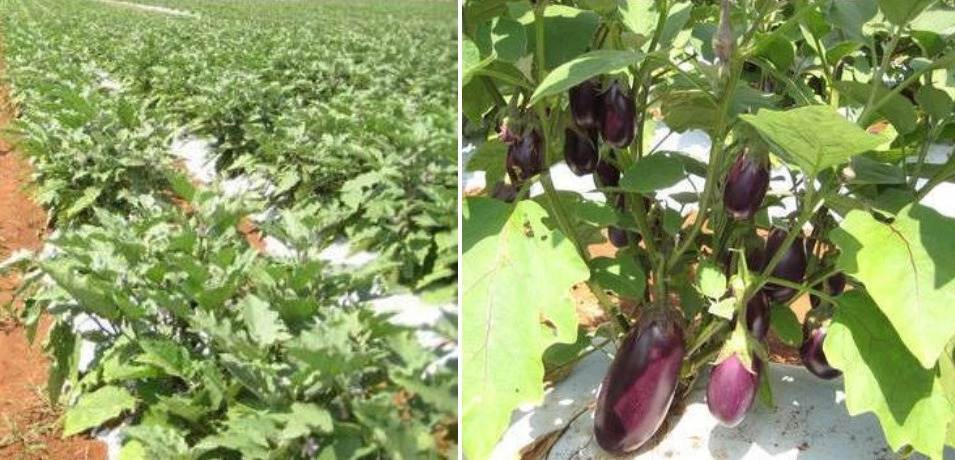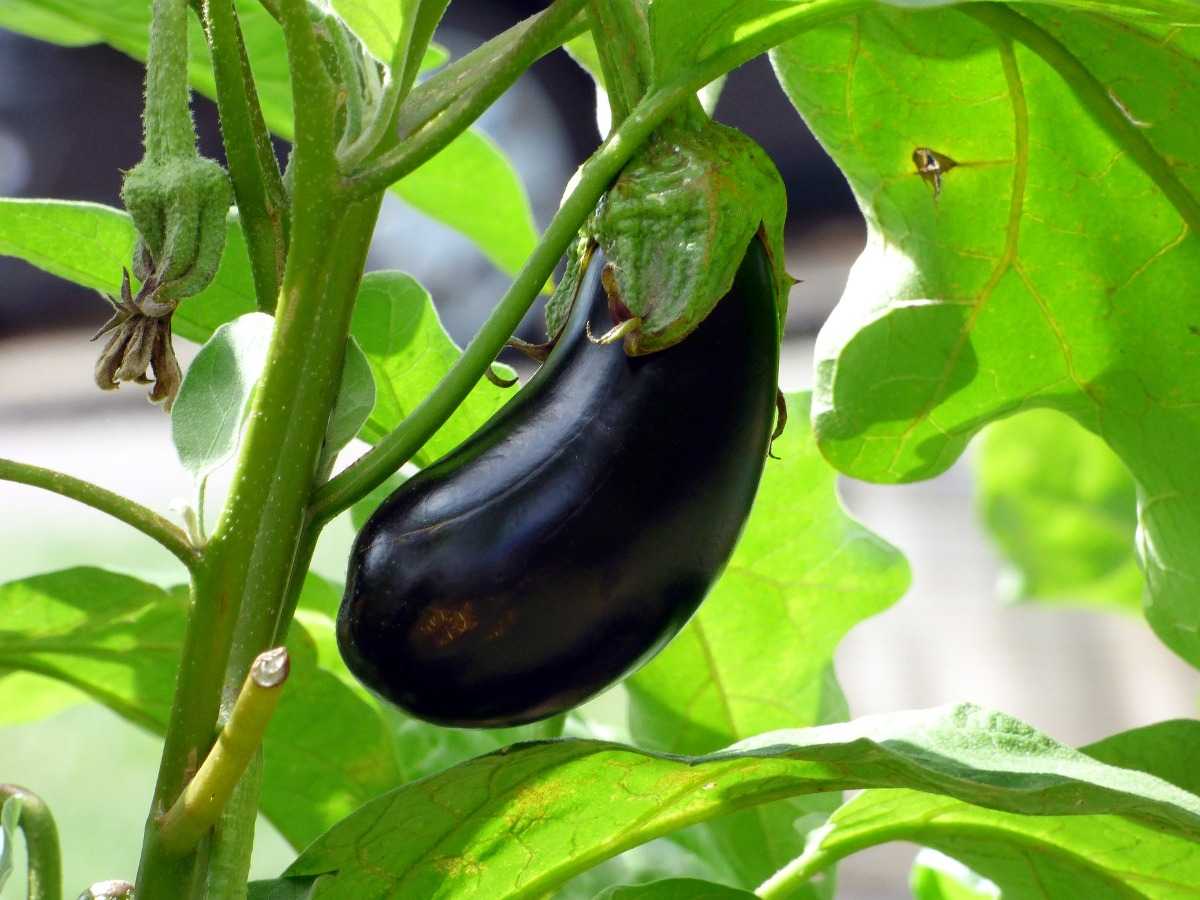Introduction to mulching Brinjal plants (Eggplants)
Brinjal commonly known as eggplant can grow under both tropical and subtropical regions of our country. It has great importance among vegetable crops because of its medicinal value. It is a warm-season crop but the yield is affected due to factors like excessive soil humidity, water stress, excessive salinity, and high temperatures. The mulching process has improved these factors and enhanced the yield by the proper growth of the plant. The major advantage of using mulch in Brinjal crop is weed control, spreading of infectious diseases, insect problems, various diseases in Brinjal plant, etc. These problems were controlled by the mulching process to a larger extent. Both organic and inorganic mulches help to improve soil properties which directly reflects the response on yield.
A step by step guide to mulching in brinjal plants

Eggplant contains the highest vitamin A content and it is proved effective for diabetic patients. Crop yield is reduced due to both biotic and abiotic factors. These can be overcome by using mulching.
Types of mulches used in Brinjal
Two types of mulches are used for the effective growth and yield of Brinjal.
Inorganic mulch for Eggplant or Brinjal
Inorganic mulches such as synthetic mulch, plastic mulch, polyethylene film, etc. are used for better growth of Brinjal.
Synthetic mulch for Brinjal
Synthetic mulch such as black plastic, polyethylene films are used for mulching Brinjal. These materials control the temperature, relative humidity, and light intensity. It also improves the soil moisture and increases the soil temperature during the winter season. The synthetic mulches increase plant characteristics like plant height, fruit yield, and stem girth.
Brinjal mulching with Polyethylene film
There is a significant increase in the fruit yield when polyethylene film is used. It increased the yield by up to 28.3% as per the research.
Plastic mulch around Brinjal plants
Plastic mulch is effective in weed control, reduced salinity, temperature control, reduces water loss from soil, etc. Apart from this it also helps the farmers in increasing the yield, crop growth, plant height, etc. Plastic mulching showed a good influence on Brinjal crop growth and yield in many of the species. In grafted Brinjal mulching with plastic of 25 micro thickness yielded the best results compared to all other inorganic mulches.
Black plastic mulch for Brinjal plants
Black plastic mulch is commonly used for large scale production of Brinjal. When compared to organic mulch black plastic mulch is effective in weed management. As you can see there are many weeds in the Brinjal field which compete with the main crop. The black plastic mulch for Brinjal gives maximum fruit yield and promotes the growth of the plant. Black plastic mulch proved to be effective in increasing the yield in Brinjal compared to other mulches. This is because it increases the soil temperature from 2-3 degrees Celsius when compared to unmulched soil during the crop season.
Colored mulches for Brinjal crop
Brinjal crop yield is increased by the use of color reflective mulch. This reduces disease along with insect pest populations. Silver gray or aluminum reflective mulches tend to improve soil quality and yield parameters. It also helps to reduce several viral diseases and increases the root growth, photosynthesis rate.
Soil health, porosity, and texture are improved by using sprayable colored soil mulches and silver mulches. Different types of colored plastic mulches used in Brinjal cultivation-
- Black colored plastic mulch warms up the soil and effective in weed control.
- White-colored plastic is the coolest of all the colored mulches but it is not much effective in weed control compared to black plastic mulch. White plastic mulch is mostly used during hot climatic conditions.
- Silver colored plastic mulch is effective in reducing weeds and even insect population in Brinjal crop production.
- Transparent plastic mulch is effective in controlling soil-borne diseases as it solarizes the soil.
- Red-colored plastic mulch is the most effective one among inorganic mulches which helps in a higher increase of yield in Brinjal crop.
Organic mulches for Brinjal cultivation
Organic mulch like straw, dry leaves, newspaper, sawdust, grass clippings, compost, etc. are the natural materials used as they can decompose very easily into the soil. In the organic mulching soil surface of the land is covered with crop remains such as maize stalk, husk, leaf stubble, and paddy straw of harvested crop. Mulching with these crop residues recorded best results in a yield of Brinjal crop and other crop cultivation. The order of variation regarding the growth of Brinjal crop is rice straw recorded greater over sawdust.
Organic mulches improve soil conditions and properties, adds organic matter, and improves nutrient content to the soil. This is the reason they are used in agriculture on a large scale especially in Brinjal cultivation.
Sugarcane Mulch for Brinjal crop
Brinjal is a Rabi season crop where mulching with sugarcane recorded the improvement of physical properties of the soil like water-stable aggregates, hydraulic conductivity, biological properties such as fungi and bacterial population, soil chemical properties like soil salinity and fertility. These were improved when organic mulch such as sugarcane mulch is used around the Brinjal crop. There is wide viability regarding the growth and yield of Brinjal crops.
Best organic mulch for Brinjal plants
The best organic mulch for Brinjal crop is rice straw as it recorded the best yield and growth over the other organic and inorganic mulches. The yield of Brinjal has increased with a drastic change by the use of rice straw mulch in the cultivation land.
Mulching Brinjal with straw mulch
Straw mulch is used for Brinjal mulching where it is placed 2-3 cm/m square. By using straw mulch the following parameters can be obtained which includes: fruit diameter, plant height, and fruit length, number of leaves, fruit yield, and number of fruit per m square. The straw mulch of 2 cm is proved to be best in Brinjal production regarding yield and yield contributing traits.
FYM (Farmyard Manure) mulch around Brinjal plants
The FYM mulch is found to be the greatest one to improve the soil properties like moisture retention capacity and hydraulic conductivity. FYM mulch also increases the absorption of minerals like Nitrogen, Phosphorous, and Potassium along with Calcium and Magnesium.
FYM mulch is found to increase the root mass density, root length, and also the root volume which helps in the highest growth of the plant as well as the yield is improved to a larger extent.
Mulching Brinjal plant with grass clippings
These grass clippings collected from the trims of the lawn becomes an excellent source for mulching Brinjal plants. Grass clippings prevent the soil from overheating. As the Brinjal is a summer crop it requires heat so you need to leave enough space around the stalks so that water and the sunlight reach the stem and the root of Brinjal easily.
Mulching of Brinjal with newspaper
Newspaper mulch is used for controlling the weeds in Brinjal cultivation. Six to eight layers of newspaper are placed around the Brinjal crop where the germination of weeds in the soil is effectively controlled. Mulching with newspapers also improves the soil moisture and helps in the better yield of Brinjal.
Step by step procedure to mulch Brinjal plants
Step 1: Spread the mulch forming a 2-4 inch layer around the Brinjal plant.
Step 2: Remove 6 steps diameter around the Brinjal plant to make a small well around the base of the plant. This aids in preventing the compaction in and around the stem that could lead to stem rot. The well-formed around the base of the plant forms a dish to intake of the water which directly reaches the root.
Step 3: If you have extra mulch then you may add it in between the rows so that the mulch controls the growth of weeds.
Step 4: Water your Brinjal plants often by monitoring the moisture content in the soil using your finger so that you will have the idea of the water content near the roots.
Step 5: Make sure that you place the mulch after 3-5 weeks so that the soil gets warmed as the Brinjal plants like heat. Allow the soil to heat up as much as possible before adding the mulch. Adding mulch too early postpones blossom and thereby fruit development is delayed.
Benefits of Mulching Brinjal plants
In case if you miss this: Organic Pumpkin Farming, Cultivation Practices.

- Regulates soil temperature: In hot summer the layer of Brinjal mulch aids in cooling the soil temperature. But in the winter season, the layer around the plants will assist in keeping the roots warm.
- Retains moisture content: The layer of mulch that spans over the soil aids in the absorption of excess water. Around 2-3 inches of mulch could be used as the outer layer will be dried early than the lower layer. This aids to reduce the moisture evaporation from the soil. Mulching effectively provides moisture for your Brinjal plants.
- Controls weed growth: Weeds are a serious threat to any cultivation especially in Brinjal farming. The application of weedicides has proved to be disadvantageous to the farmland. Mulching is the descent resolution for effective control of weeds in Brinjal farming.
- Protects soil from erosion: The top layer of the soil is effectively protected with the use of organic mulches. These mulches also sustain the nutrient capacity of the soil because they release the nutrients slowly into the soil through natural degradation.
- Prevents plant from fruit rot and fungal diseases: Mulching forms as a layer on the soil surface which helps in avoiding the bacteria and fungi from the soil that enter into the plants. When the Brinjal falls onto the mulch the possibility of causing rot is reduced if compared to the fall onto the soil.
Disadvantages of mulching in Brinjal plants
Not only advantages, but there are also some disadvantages to Brinjal mulching. Mulching of Brinjal with straw or hay will create a habitat for slugs. The wood chips are responsible to attract rodents and some kind of pests. In case you plan to use plastic then it will pose some disadvantages.
In case if you are interested in How to Make Money from Organic Farming Business.
It is a very useful blog and very important information about Plastic Mulch.